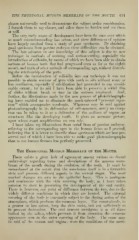Page 601 - My FlipBook
P. 601
THE EMBRYONAL MUCOUS MEMBRANE OF THE MOUTH. 611
almost universally used to demonstrate the subject under consideration.
I furnish them to my classes, and allow them to harden and cut them
at will.
The very early stages of development have been the ones over which
so much misunderstandmg has arisen, and these differences of opinion
have largely resulted from a study of poor specimens. By obtaining
good specimens from porcine embryos these difficulties can be obviated.
The late advance in our knowledge of this subject is due to new
technique in methods of staining and section-cutting, especially the
introduction of celloidin, by means of which we have been able to obtain
sections of human teeth that had progressed even as far as the eighth
month, and teeth of other animals of corresponding age, without disturb-
ing the relationship of the parts.
Before the introduction of celloidin into our technique it was not
possible to obtain sections of jaws with teeth in situ Avithout more or
less mutilation, especially if calcification had proceeded to any consid-
erable extent ; by its aid I have been able to preserve a serial line
of slides without break or tear in the sections employed. And,
further, the illustrations made by the new process of photolithograph-
ing have enabled me to eliminate the much-tabooed " personal equa-
tion" which accompanies wood-cuts. Whatever may be said against
photomicrography in its delineation of cell-structure, surely no excep-
tion can be taken to it as a delineator of the outliaies of organs . or
structures like the developing tooth. It gives an accurate picture,
upon whose exact amplification we can rely.
I have taken my illustrations from serial lines of porcine embryos,
referring to the corresponding ages in the human foetus as I proceed,
believing that it is better to describe those specimens which are best pre-
served and of which I have been able to make good photomicrographs
than to use human foetuses less perfectly preserved.
The Embryonal Mucous Membrane op the Mouth.
There exists a great lack of agreement among writers on dental
embryology regarding terms and descriptions of the mucous mem-
brane of the mouth during the evolution of the teeth. It must be
rememl)ered at the outset that the membrane itself is in a formative
state and presents different aspects in the several stages. The most
marked changes are seen in the epithelial layer. This is analogous
and continuous with the skin covering the body, as I have taken
occasion to show in presenting the development of the oral cavity.
There is, however, one point of difference between the two, due to the
widely different conditions in Avhich they are located. The external
covering of the body is constantly subject to the drying action of the
atmosphere, which produces the corneous layer. The sweat-glands, to
a greater or less extent, keep the skin moist, but not sufficiently so
'to prevent desiccation. The oral mucous membrane is at all times
bathed by the saliva, which prevents it from assuming the corneous
appearance seen in the outer covering of the body. The same may
be said of the rectum and vagina : were the conditions of the mem-


